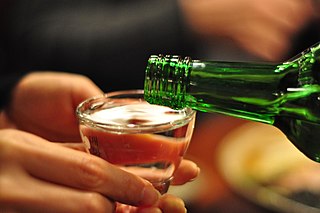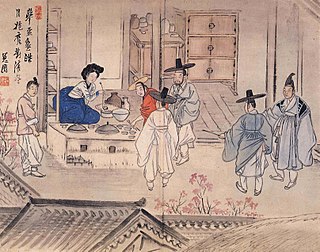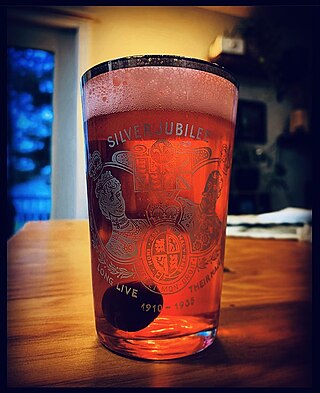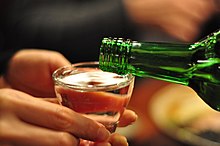
Soju is a clear and colorless distilled alcoholic beverage, traditionally made from rice, but later from other grains and has a flavor similar to vodka. It is usually consumed neat. Its alcohol content varies from about 12.5% to 53% alcohol by volume (ABV), although since 2007 low alcohol soju below 20% has become more popular.

A boilermaker is either of two types of beer cocktail. In American terminology, the drink consists of a glass of beer mixed with a shot of whiskey.

Drinking culture is the set of traditions and social behaviours that surround the consumption of alcoholic beverages as a recreational drug and social lubricant. Although alcoholic beverages and social attitudes toward drinking vary around the world, nearly every civilization has independently discovered the processes of brewing beer, fermenting wine, and distilling spirits, among other practices. Many countries have developed their own regional cultures based on unique traditions around the fermentation and consumption of alcohol, which may also be known as a beer culture, wine culture etc. after a particularly prominent type of drink.
HiteJinro Co., Ltd. is a South Korean multinational drink, brewing and distiller company, founded in 1924. It is the world's leading producer of soju, accounting for more than half of that beverage's domestic sales. It also manufactures a variety of other alcoholic beverages including red wine and whiskey. Distilleries are located in Icheon, Cheongwon, and Masan, with the Masan plant geared toward exports. In addition, Jinro produces the Soksu brand of bottled water at a factory in Cheongwon. In 2006, the company was acquired by Hite, a popular beverage company whose main product is beer.

Korean cuisine has a wide variety of traditional alcoholic drinks, known as sul (술). Many of these drinks end with the Sino-Korean word -ju, and some end with the native Korean word -sul. The Sino-Korean -ju is not used as an independent noun.

Various unique terms are used in bartending.
Yorsh, also known as mora grogg, is a Russian mixed drink consisting of beer thoroughly mixed with an ample quantity of vodka. It is traditionally drunk in a social setting, typically with a toast followed by downing a full glass of it at one go. It is commonly consumed in Russia. The term is colloquially used similarly to the "jungle juice" in English to designate an alcoholic mix of incompatible ingredients.

An Irish car bomb, Irish slammer, Irish bomb shot, or Dublin drop is a cocktail, similar to a boilermaker, made by dropping a bomb shot of Irish cream and Irish whiskey into a glass of Irish stout.

A shooter, or shot, is a small serving of spirits or a mixed drink, typically consumed quickly, often in a single gulp. It is common to serve a shooter as a side to a larger drink.

A beer cocktail is a cocktail that is made by mixing beer with other ingredients or another style of beer. In this type of cocktail, the primary ingredient is usually beer.

Drinks containing alcohol are typically divided into three classes—beers, wines, and spirits—with alcohol contents between 3% and 50%.

A bomb shot, depth charge, or drop shot (Canada) is a kind of mixed drink. A drink in a small glass is dropped into a larger glass holding a different drink. The resulting cocktail is typically consumed as quickly as possible ("chugged").

Korea's drinking culture interfaces deeply with its social structure, lifestyle, and traditions. The beverages themselves are also reflective of the country's varying geography, climate, and culture.

Somaek (Korean: 소맥) is a South Korean beer cocktail made with soju and beer. The beer used is typically a lager-style.

Tōkki Soju is a brand of soju founded in Brooklyn, New York in 2016 by master distiller Brandon Hill. The company prides themselves on quality over profit, using expensive ingredients that contribute to taste such as glutinous rice.

North Korean cuisine is the traditional culinary practices and dishes of North Korea. Its foundations are laid by the agricultural and nomadic traditions in southern Manchuria and the Korean Peninsula. Some dishes are shared by the two Koreas; however, availability and quality of Northern cuisine is much more significantly affected by sociopolitical class divides.
Hoesik is a popular type of gathering in the society of South Korea, and refers to a group of people getting together to eat and drink. In Korean society, Hoesik has been established as a subculture of an organization or enterprise. In Korean corporate culture, Hoesik which have been a longstanding tradition, typically take place after work hours. However, such events have come under scrutiny as social issues due to the collectivist nature of Korean corporate culture, which has led to structural problems characterized by rigidity and coercion.














